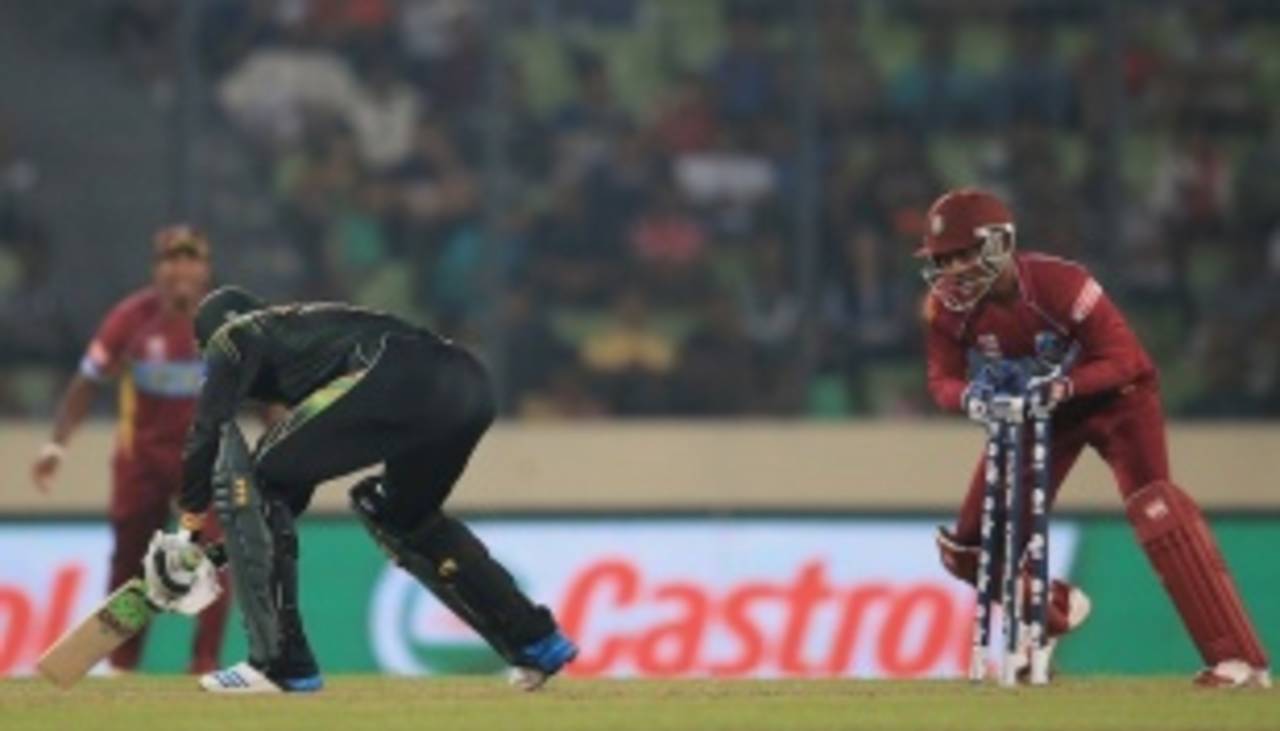Pakistan consumed by waves of panic
The performance against Australia gave Pakistan fans hope but, not for the first time, they produced a polar opposite display
Abhishek Purohit in Dhaka
01-Apr-2014

Shoaib Malik was one of four players stumped as Pakistan were consumed by panic • AFP
Pakistan never fail to surprise us, do they? If you had come expecting a thriller between two similar, explosive T20 sides, what you got instead was Pakistan showing us multiple, and all equally self-destructive, states of panic.
Two of their best bowlers, Saeed Ajmal and Umar Gul, cracked under pressure and gave away a combined 59 runs in three overs at the death. The top order went down heaving, and the middle order shut shop in response.
It was one of those nights from Pakistan. As was the night when they had sparked that incredible Australian collapse earlier in the tournament. We know both happened, separated by a matter of a few days. We also know Pakistan are capable of both kinds of displays within such a short span. We can try to delve into what happened and how it happened. Exactly why it happened, we will never really know.
Each wave of panic against West Indies only brought about another, albeit different one, from the following cast. When the opposition is 84 for 5 after 15 overs, and you have overs left from two of the most experienced and best T20 bowlers in the world, the last thing you are expecting is for both of them to lose it suddenly. And Gul lost it so much in the 18th over that as many as three fielders ran up to him at various points in the over with words of advice, or encouragement, or whatever it was that they felt could work at that moment.
Mohammad Hafeez, Shahid Afridi, Sohail Tanvir. All those interventions did not stop the over from going for 21. They also revealed Pakistan's state of mind at that point. When three different men are needed to rush to your premier fast bowler, all in the span of half an over, you tell the opposition you are on the edge, and are expecting the worst.
And the worst came in the next over. Ajmal is usually the master of these situations. He will toss one up a bit more, or he will hold it back a bit more, or he will bowl the one that turns the other way from which the batsman was expecting it to. And the batsman will have a clueless slog and fall. None of this was happening. Ajmal instead bowled short, he bowled flat, he bowled quickly. He became what your average spinner is usually at the death in limited-overs cricket - a massive risk. For that one over, he lost the aura that makes him Saeed Ajmal. He will doubtless regain that, as he did after the 2010 World T20 semi-final, but the damage had been done again.
Heaven knows how the Pakistanis felt walking off the field at the break, having allowed West Indies to nearly double their score in five overs. Heaven knows what was spoken in the Pakistan dugout at the break. All we saw was that their top order and middle order came out in two extreme states of trance - one suicidal by dint of action, one suicidal by dint of not acting at all.
Ahmed Shehzad can be excused for getting a ripper of an inswinging yorker first ball. Kamran Akmal, Umar Akmal and Shoaib Malik cannot be. Not for facing a collective, unproductive 14 deliveries between them. But for reacting in such a frenzied manner that would have you believe they had been collectively unproductive for 14 overs, and that frenzy was the only way out.
To be 13 for 4 in the sixth over is nowhere near the start you want when you are chasing 167 in a virtual quarter-final. To bottle up like Sohaib Maqsood, and particularly Hafeez, did is probably the worst response you want from your middle order when you are 13 for 4.
Pakistan consumed 40 deliveries before they hit their first boundary. One-third of a T20 innings without a single boundary. One-third of a 20 innings that had already seen a batsman heave to mid-off, and two batsmen stumped. And yet, there was not a single boundary during the fielding Restrictions. Maqsood and Hafeez added 24 in five overs. And then fell within an over of each other. It was like the cast of a play frozen in extreme stage fright after the opening acts had bungled their lines by trying too hard too soon.
If you admire Pakistan cricket for showing you the Australia collapse, tonight you were dealt so many shocks you went numb. You then attempted to make sense of each of them. Batsmen throw their bats around in T20, and as Dwayne Bravo said, even the best bowlers go for runs at the death. The top order had no choice but to try and make the most of the fielding restrictions. The downside was that they could fall while doing so, and they did. The middle order, as Hafeez said, was faced with too many jolts too soon and had absolutely no momentum to build on.
You weigh up all these arguments. Maybe they are justified standalone, maybe they are not. But how do you find explanations for such a collective and varied brain freeze? Which is why, exactly why it happened, we will never really know.
Abhishek Purohit is a sub-editor at ESPNcricinfo